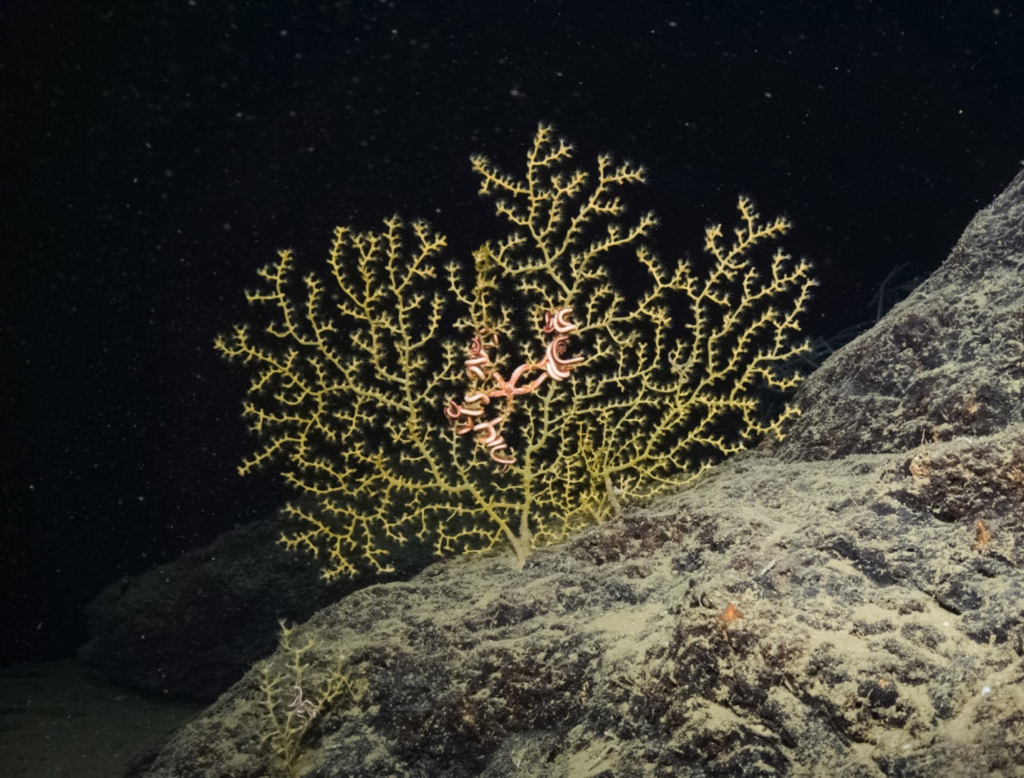
Once a deep-sea Paramuricea coral was exposed to oil and dispersants, the damaged areas became ripe for colonization by other parasitic corals. Here, the coral is being completely overgrown by purple Trachythela corals. (Credit: NOAA, Oceaneering)
Delicate and damaged
Every year from 2010 to 2017, scientists visited those three sites to monitor damages, measure growth rates and note any recovery of the corals, as part of a large initiative aiming to better understand ecosystem impacts and improve our ability to respond to future oil spills. They used a remotely operated vehicle to take high-resolution photographs of corals at all three impacted sites and two far-removed reference sites, tracking more than 300 corals overall.
The researchers visited these sites again in 2022 and 2023 as part of the Habitat Assessment and Evaluation project, one of the projects funded through the Natural Resource Damage Assessment settlement. The images allowed the team to measure changes to coral health over time, including noting any breaks along the delicate branches of the coral caused by exposure to oil pollution.

Healthy Paramuricea biscaya coral is bright yellow, like this specimen in a reference are far from exposure to the 2010 Deepwater Horizon. Researchers compared corals from this area to corals growing near the spill. (Credit: NOAA, Pelagic Research Services)
Still suffering after all these years
The scientists found that even by 2022, the affected corals continued to show signs of stress and damage from the oil spill. The brown coating they had first observed was long gone, but upon closer inspection, the corals were weak and prone to breaking. The scarred spots where branches fell off were leaking mucus, and some corals whose skeletons were exposed had been colonized by other, parasitic coral species.
"Not only were some of these corals not recovering, but some of them seemed to be getting worse," Girard said. She added that if the impacts are too heavy, ecosystems can struggle to recover at all, especially given the onslaught of climate change-related stressors like ocean acidification. "It's really important to prevent damage in the first place, and the way to do that is through protection measures."
Girard notes that their work is being used to inform restoration strategies, including trying to grow deep-sea corals for coral propagation from transplants, deploying artificial anchoring sites for recolonization or protecting the deepwater communities and letting nature heal itself. In the coming years, the team will continue to monitor to corals, looking for signs that they're getting better - or worse.
#
Abstract information
Tuesday, 20 February 2024, 15:17- 15:28, R09, second floor
More on corals:
Can't get to a reef? Try visiting its digital twin instead
Monday 4:00 PM Poster Hall, First Floor
Marine heatwaves associated with coral bleaching are extending deeper and lasting longer
Thursday 2:00 PM Great Hall A, First Floor
Extreme marine heatwaves of 2023 and severe coral bleaching
Thursday 2:00 PM Great Hall A, First Floor






